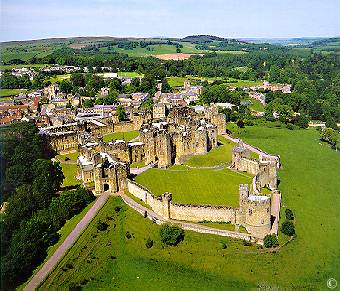Dining Out in the Fourteenth Century
Invitation
You are cordially invited to celebrate the Holy Day of the Assumption of the Blessed Mary with our Lord de Percy, other nobles of our country, and the Abbot of Alnwick.
Walter de Hepsecotes, Abbot of Alnwick.
Thomas de Boynton was one of the thirteen knights -- "nobles of our country" -- who accepted the invitation, according to the chronicler.
At the instance of Walter de Hepescotes, Abbot of Alnwick, our most skilful father, and flourishing in religious fame; our noble patron, Henry, the fifth Lord de Percy, in the year of our Lord, 1376, on the day of the assumption of the blessed Mary, dined in our refrectory with thirteen knights, the names of whom where these: Sir William de Acon, Sir Richard Tempest, Sir Walter Blount, Sir Alan de Heton, Sir John Coniers, Sir John Heron, Sir John de Lilleburum, Sir Thomas de Ilderton, Sir Thomas de Boynton, Sir Ingram de Umfraville, Sir John de Dichaunt, Sir John de Swynton, Sir Ralph de Viners, and many other nobles of the country. The cloister being filled with our parishioners and the commons of the country, the persons eating in the cloister were computed of all ages at that repast, 1020; the men in the refectory, 120; to the second repast in the refectory, 86. [Archaeologia Aeliana, 1844]
The Abbey was home for the fifth Lord de Percy. It was on the grounds of
Alnwick castle,  which
was one of the major centers of Percy land and wealth. The grandfather of
this Lord de Percy had acquired the castle, land and abbey in 1309, and the
castle and land have remained a center of family wealth even until today.
We are told that the castle pictured here has been reconstructed back to its
origins -- with the exception of electricity, running water, heating, etc.
of course.
which
was one of the major centers of Percy land and wealth. The grandfather of
this Lord de Percy had acquired the castle, land and abbey in 1309, and the
castle and land have remained a center of family wealth even until today.
We are told that the castle pictured here has been reconstructed back to its
origins -- with the exception of electricity, running water, heating, etc.
of course.
But it was not home, or even down the street, for Thomas de Boynton. His principal holdings were at Acklam, Roxby and Boynton -- the Boynton triangle. We do not know about the fourteenth century roads, but as the crow flies [inches on the map] it was 65 miles from Acklam to Alnwick, and 90 miles from Roxby to Alnwick, and 120 miles from Boynton to Alnwick. Given the rather modest horsepower available to Thomas this made dining out with the Abbot a substantial undertaking. And it was a comparably long trip for other members of the party. The Conyers held land in the North and West Ridings of Yorkshire. The Atons had land in the North and East Ridings of Yorkshire.
It is all about pace. Dining out in Iowa City is a matter of a ten minute automobile ride. Maybe it is thirty or forty-five minutes if you live in a city. But in the fourteenth century dining out was a multi-day trip. We know this was a regular feature of their lives. Thomas had a number of manors, and he moved between them to take care of his business. And those were multi-day travel, as well. They did not have watches, but they did not need them. We live on a time scale of minutes. They lived on a time scale of days. If everything takes days you do not need to keep track of the minutes.
It was an important religious holy day. The knights traveled from afar. One hundred and twenty of the most important citizens of northern England assembled to celebrate the holiday. And the parishioners assembled as well -- one thousand strong -- joining in the celebration in the outer cloister at the feet of the nobles.
Our holy days at the University of Iowa are football Saturdays. The president invites all of the rich people who can fit in the box to be wined and dined and entertained. You cannot see the football game very well from the box atop the stadium, but you have a great view of the tens of thousands of people at your feet.
The telling points in this story are three:
It is difficult to not be surprised by the mobility of the nobles of the fourteenth century. Travel was tedious, at best. Yet, their lives were organized around days of travel to proceed to another manor, to witness deeds, to the county court, to a celebration.
Their celebrations, the events that drew a crowd were holy days. No football games -- neither English nor American football. Religion was a central organizing feature of their lives.
The job of the Abbot was raising money -- not saving souls. The job of the university president is raising money -- not learning. And the strategy for making rich people feel important does not seem to have changed much.
....